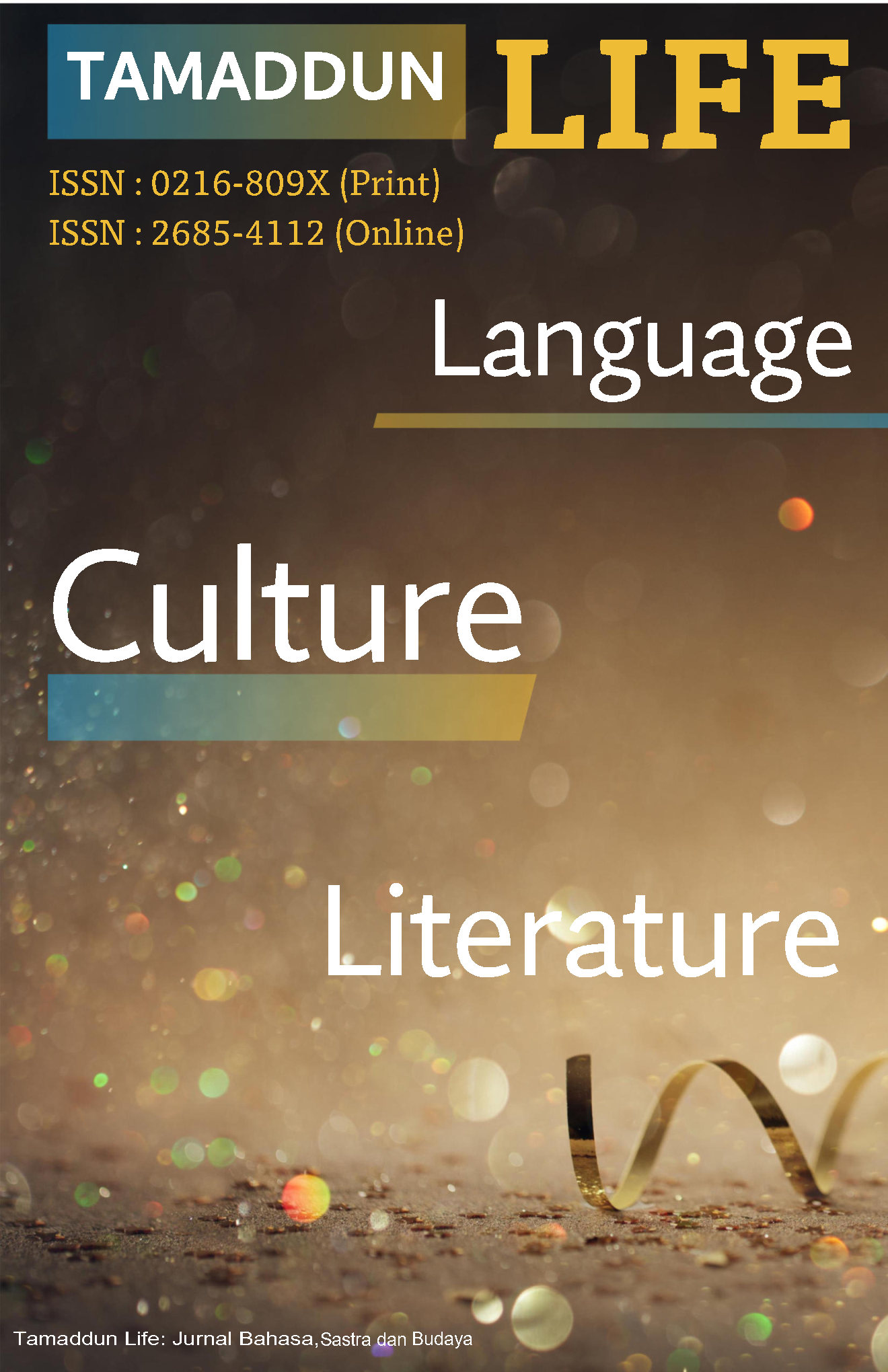The Price of Appearances: Materialism in Maupassant’s The Necklace and Modern Consumer Culture
DOI:
https://doi.org/10.33096/tamaddun.v24i1.933Keywords:
Reception Theory, Dominant-Hegemonic, Negotiated, Oppositional Position, The NecklaceAbstract
This study aims to explore the readers’ reception on The Necklace short story based on Hall’s reception theory. Employing descriptive-qualitative research design, the study focuses on Hall’s three main reading positions: the dominant-hegemonic, in which the reader decodes the message as intended by the author; the negotiated, where the reader partly accepts and partly resists the message; and the oppositional, where the reader rejects the encoded message entirely. Data were collected through two main instruments: students’ intellectual diaries (reflective journals) and classroom discussions. Data analysis follows Braun & Clarke’s thematic analysis. The findings of this study provide a nuanced understanding of how university students interpret Maupassant’s The Necklace in relation to materialism and contemporary consumer culture, viewed through the lens of Hall’s reception theory. The students’ responses, categorized into dominant-hegemonic, negotiated, and oppositional readings, reveal the multiplicity of interpretive positions shaped by ideological alignment, personal experience, and sociocultural context. This study shows that The Necklace story remains a powerful and relevant story, offering rich opportunities for critical engagement and reflection in the classroom. It becomes evident that literary texts are not static but dynamic sites where meaning is contested and reinterpreted across time and space. This study has shown that literature remains an essential tool for fostering critical thinking and for engaging students with the social, cultural, and ideological issues of their time.
References
Baudrillard, J. (1998). The Consumer Society: Myths and Structures. London: Sage Publications.
Bauman, Z. (2007). Consuming Life. Cambridge: Polity Press.
Beach, R. (1993). A Teacher’s Introduction to Reader-Response Theories. Urbana, IL: National Council of Teachers of English.
Beaumont, C. M. (2022). Beyond vanity: Socioeconomic critique in Maupassant's short fiction. Nineteenth-Century French Studies, 48(2), 217-233. https://doi.org/10.1353/ncf.2022.0015
Bourdieu, P. (1984). Distinction: A Social Critique of the Judgement of Taste. Cambridge, MA: Harvard University Press.
Creswell, J. W., & Poth, C. N. (2018). Qualitative Inquiry and Research Design: Choosing Among Five Approaches (4th ed.). Thousand Oaks, CA: SAGE Publications.
Featherstone, M. (1991). Consumer Culture and Postmodernism. London: Sage.
Fereday, J., & Muir-Cochrane, E. (2006). Demonstrating rigor using thematic analysis: A hybrid approach of inductive and deductive coding and theme development. International Journal of Qualitative Methods, 5(1), 80–92.
Fish, S. (1980). Is There a Text in This Class? The Authority of Interpretive Communities. Cambridge, MA: Harvard University Press.
Fiske, J. (1987). Television Culture. London: Methuen.
Freire, P. (1970). Pedagogy of the Oppressed. New York: Herder and Herder.
Hall, S. (1980). Encoding/decoding. In S. Hall, D. Hobson, A. Lowe, & P. Willis (Eds.), Culture, Media, Language (pp. 128–138). London: Hutchinson.
Hasbi, M., Bakri, F. & Halim, A. (2025). Enhancing Students Literacy through Intellectual Diary: A Classroom Approach. ELS Journal on Interdisciplinary Studies in Humanities, 8(1), 99-107. https://doi.org/10.34050/elsjish.v8i1.43364
Hasbi, M. & Bakri, F. (2024). Beyond the Text: Using English Prose to Expand Students’ Cultural Horizons. Proceedings of the 7th Celt International Conference (CIC 2024), Advances in Social Science, Education and Humanities Research 897, https://doi.org/10.2991/978-2-38476-348-1_23
Hasbi, M., Mahmud, M., & Halim, A. (2023). Lecturer’s Perception on the Integration of 21st Century Learning Skills in the Teaching of English Prose. ELT Worldwide: Journal of English Language Teaching, 10 (2), 300-311. http://dx.doi.org/10.26858/eltww.v10i2.50610
Hooks, B. (1994). Teaching to Transgress: Education as the Practice of Freedom. New York: Routledge.
Holub, R. C. (2023). Reception theory in the digital age: Victorian classics in contemporary classrooms. Comparative Literature Studies, 57(4), 412-429. https://doi.org/10.5325/complitstudies.57.4.0412
Machor, J. L., & Goldstein, P. (Eds.). (2001). Reception Study: From Literary Theory to Cultural Studies. New York: Routledge.
Maguire, M., & Delahunt, B. (2017). Doing a Thematic Analysis: A Practical, Step-by-Step Guide for Learning and Teaching Scholars. The All Ireland Journal of Teaching and Learning in Higher Education, 9(3), 3351-33514. https://doi.org/10.62707/aishej.v9i3.335
Morrell, E. (2008). Critical Literacy and Urban Youth: Pedagogies of Access, Dissent, and Liberation. New York: Routledge.
Peterson, S. J. (2023). Maupassant's cautionary tales: Victorian lessons for the digital age. Journal of Literary Criticism, 42(3), 118-136. https://doi.org/10.1177/03060315231567898
Rosenblatt, L. M. (2021). The reader, the text, the poem: The transactional theory of the literary work. Southern Illinois University Press. https://doi.org/10.2307/j.ctv1v3gq8w
Rosenblatt, L. M. (1995). Literature as Exploration (5th ed.). New York: Modern Language Association.
Shor, I. (1992). Empowering Education: Critical Teaching for Social Change. Chicago: University of Chicago Press.
Storey, J. (2018). Cultural Theory and Popular Culture: An Introduction (8th ed.). London: Routledge.
Sulistiawati, Hikmah, N. & Hasbi, M. (2024). Unveiling Wordsworth's Daffodils: A Semiotic Tapestry of Signs and Symbols. GLENS: Global English Insights Journal, 1(2), 76-88. https://doi.org/10.61220/glens.v1i2.375
Downloads
Published
Issue
Section
License
Copyright (c) 2025 Fitriani Bakri, Muhammad Hasbi, Abdul Halim

This work is licensed under a Creative Commons Attribution 4.0 International License.
Authors who publish with Tamaddun journal agree to the following terms:
1. Authors retain the copyright and grant Tamaddun the right of first publication. The work will be licensed under a Creative Commons Attribution License (CC BY 4.0), which permits others to share the work with proper acknowledgment of the authorship and initial publication in this journal.
2. Authors may enter into additional non-exclusive agreements for the distribution of the published version of their work (e.g., posting it to an institutional repository or including it in a book), provided that the initial publication in this journal is acknowledged.
3. Authors are encouraged to post their work online (e.g., in institutional repositories or on their personal websites) before and during the submission process. This can lead to productive exchanges and increase the visibility and citation of the published work.






